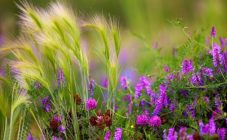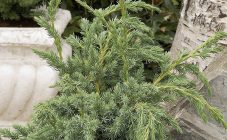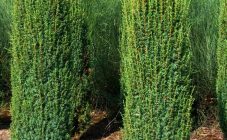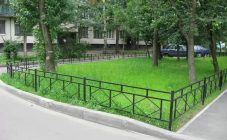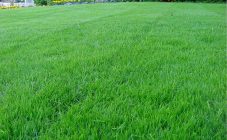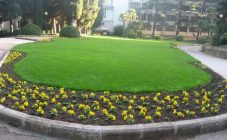Content:
A few years ago, artificial turf seemed like a real exotic. However, now synthetic turf is gradually becoming fashionable. It is not difficult to take care of them, the main thing is to know how to use them correctly to decorate the space.
Artificial grass for decoration: description, scope
It is quite difficult to take care of the turf on the site. In order to keep it in exemplary order, the summer resident will certainly need a lawn mower. Therefore, in recent years, more and more amateur gardeners are choosing artificial lawns.
There are situations when it is definitely worth making a choice in favor of synthetic turf. Experts recommend purchasing an artificial turf if:
- Children and pets walk on the site every day, cattle graze. In this case, the real grass will be quickly trampled, and the synthetic turf can easily withstand such a load.
- On poor, infertile or stony soil, true plants do not grow well.
- The site is located in a lowland, the soil is very wet and moss is rapidly multiplying on it. In this case, installing artificial turf is a great way to deal with lichens, mosses and fungi.
- If the area is located directly in the sun, and real grass quickly turns yellow and dries up.
In all these cases, it is possible to give the territory an aesthetic appearance with the help of a grass covering made of artificial materials. Also, such a lawn will be an ideal solution if there is a playground or an active recreation area in the country (a pond or a swimming pool, a fitness corner).
Varieties of herbs for decoration
Artificial turf grass differs in size, materials of which it is made, and scope.
Dimensions and height
Decorative artificial grass can be of different sizes. It can be high or low, and individual blades of grass are wide or narrow, with a smooth or rough surface.
Traditionally, grass is produced from synthetic materials with a pile height:
- 20 mm;
- 40 mm;
- 50 mm;
- 60 mm.
The standard height is the smallest - 20 mm. Lawns with this pile height are used not only in summer cottages, but also on football fields.
By area of use
The plot, beautifully decorated with artificial grass, resembles a bright theatrical setting. In addition, it is easier to care for such a lawn than for a real one.Therefore, most often, plastic herbaceous plants are used for garden decoration.
Main areas of use:
- playgrounds for sports games;
- interior design (in children's rooms, sometimes in living rooms);
- registration of summer cottages;
- landscape design.
When purchasing an artificial lawn for a summer cottage, it is best to choose a shade that is as similar as possible to the color of real green plants.
By material of manufacture
Artificial grass for decoration can be made from different polymeric materials. Most often, synthetic lawns are made from polyethylene. This material is truly versatile: it is inexpensive, lasts a long time and lends itself well to coloring in any colors and shades.
The main advantage of polyethylene is its softness. Such a coating is perfect for an area where there are children.
Polypropylene lawns have a stiffer pile. They are rarely used in the country. Basically, polypropylene grass is used to cover sports fields and courts. The base of the lawn is usually made of high quality latex, so it is resilient and resilient. "Blades of grass" can "grow" in different directions.
Where can you use artificial grass in your summer cottage
Artificial grass for decoration is very popular with Russian summer residents and landscape designers. Below are illustrative examples with description:
- Synthetic covering in the cemetery. A piece of synthetic grass cut from a roll is placed in a rectangular stone cavity for planting flowers. The rest of the burial area is also decorated with artificial grass. After that, the green background is decorated with any artificial flowers. The bright green polyethylene grass "carpet" goes well with white granite, always looks elegant and well-groomed and relieves the owner of the need to regularly weed out the grass.
- Synthetic flooring in the country. For a summer cottage, you can take several rolls of various shades, cut them into pieces, and then lay out the simplest geometric ornament from these pieces (for example, a "chess" or zigzag pattern). You can also buy artificial grass already decorated with flowers. It is good if the shade of the synthetic "carpet" resonates with the shade of the foliage of fruit trees and berry bushes that are on the site.
- Artificial grass on the playground. In this case, it is possible not to cover the entire area entirely, but to create several "green islands" on the territory so that children can use them in their active games. On synthetic grass, you can place figures bought or made with your own hands, depicting the favorite fairy-tale heroes of children.
How to lay artificial grass: styling and fastening features
The plastic decorative grass is firmly attached to the base and then rolled into a roll. Recently, artificial grass tiles have also appeared on the market. Laying tiles is more difficult than laying a roll: all the villi must "grow" in one direction, and it is also necessary that the tiles fit snugly together, without gaps between them.
During installation, keep in mind the following:
- Before laying the grass, the site is dug up and leveled, debris, stones, old branches and leaves are removed.
- If the area is irregular (for example, narrow and elongated), the roll is cut into two (or more) pieces, which overlap each other.
- After that, you cannot walk on the grass for a day.At this time, the villi are aligned, acquiring the most natural position.
- After 24 hours, pieces of the roll that go beyond the boundaries of the area to be drawn are neatly cut off. What is left is firmly glued or stitched together so that one large canvas of the desired geometric shape is obtained.
- In order for the edges to be always even and neat, nails are driven in along the perimeter. Also, the perimeter can be fenced with wooden slats.
If tiles are used, there should be gaps between them in which natural grass grows. In this case, you need to ensure that the color of the artificial and natural turf is as similar as possible.
Additional use of artificial grass on the walls of the house
The wall of the house, covered with a green plastic carpet, looks stylish and original. Artificial plants reliably protect the wall from the appearance of fungus and provide a little insulation. However, the use of synthetic turf in the interior is not recommended for the following reasons:
- The material from which the grass is made can cause allergies in children.
- Against the backdrop of a thick green carpet, it is difficult to see ceiling or roof leaks.
- In the event of a fire, the plant finish can instantly ignite.
- The abundance of bright green can be unpleasant for the psyche.
Covering the outside walls with artificial plants, you can lay out both a solid carpet and various patterns from a roll cut into fragments. In the second case, it is recommended to draw a preliminary sketch and check with it while working on vertical landscaping. You should pay special attention to the reliability of the fastening: falling off the wall, a green carpet can injure a person walking by.
Synthetic grass can be a lifesaver for those who don't have time to care for a real lawn. With its help, you can easily transform a summer cottage.





